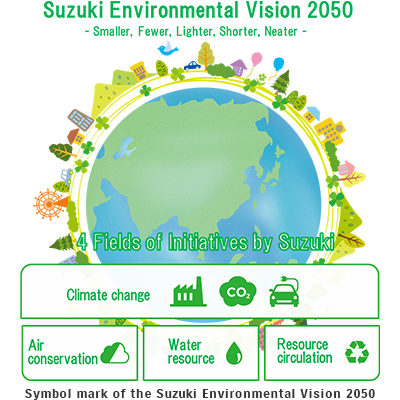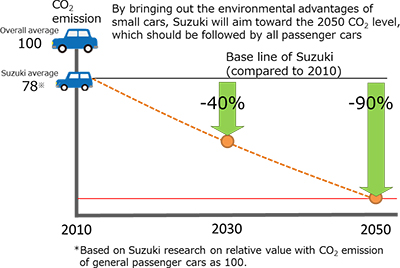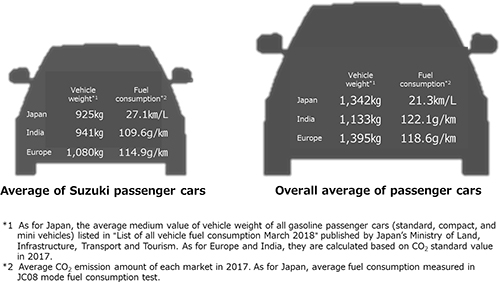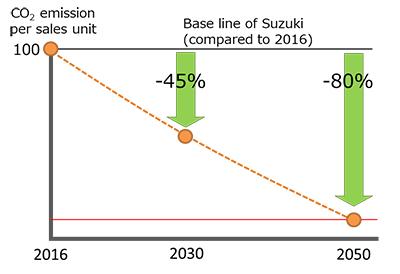Suzuki Announces the Suzuki Environmental Vision 2050
Suzuki Motor Corporation has announced a long-term vision toward tackling environmental issues, the Suzuki Environmental Vision 2050, which presents the ideal appearance of the company in 2050, as well as the Milestone 2030 toward realizing the vision.

“Smaller, fewer, lighter, shorter, and neater”: these are the words which Suzuki has been raising since the early 1990s to express the base of manufacturing. While maximizing the value offered to customers, these words are meant to make things smaller with fewer resources, with lighter weight, in shorter time and distance, and neater as much as possible.
We believe that this “smaller, fewer, lighter, shorter, and neater” concept applies to the initiatives toward tackling global environmental issues including climate change, water shortage, and resource depletion. For example, our specialized small cars, with their small and lightweight bodies, not only do they emit less CO2 but also minimize resources needed to produce them, and thus they have contributed in conserving resources as well.
Under the Suzuki Global Environment Charter, which sets Suzuki’s philosophy and basic policy toward the environment, we have made the Suzuki Environmental Plan 2020, and the Suzuki Group has been working for environmental conservation, aiming to contribute to the society and become a company loved and trusted throughout the world. As the requests for long-term initiatives toward the environment such as the climate change is increasing, and on the occasion of the company’s 100th anniversary, we have set the Suzuki Environmental Vision 2050 as a compass toward 2050, in order to become a sustainable company that would continue contributing to the society for the next 100 years.
Based on the “smaller, fewer, lighter, shorter, and neater” concept, Suzuki will aim to realize our ideal future which makes environmental impact from our business activities smaller and fewer, makes environmental load lighter, shortens the time to tackle various environmental issues, and keeps the earth bountiful and beautiful.
1. Climate change
<CO2 emitted from products>
[Environmental Vision 2050]
Reduce CO2 emitted from new automobiles by 90% in Well-to-Wheel base compared to FY2010 by 2050
[Milestone 2030]
Reduce CO2 emitted from new automobiles by 40% in Well-to-Wheel base compared to FY2010 by 2030
*Well-to-Wheel: A method in considering CO2 emitted from excavating and refining fuel as well as in generating electricity, in addition to CO2 directly emitted from the tailpipe of vehicles upon driving.

(Reference) Comparison between environmental performance of Suzuki and the overall average

<CO2 emitted from business activities>
[Environmental Vision 2050]
Reduce CO2 from business activities by 80% in base unit per sales unit compared to FY2016 by 2050
[Milestone 2030]
Reduce CO2 from business activities by 45% in base unit per sales unit compared to FY2016 by 2030

2. Air conservation
[Environmental Vision 2050]
Minimize air-polluting substances emitted from business activities and products by 2050
[Milestone 2030]
By 2030:
- - Reduce use of fossil fuel in business activities and expand use of renewable energies
- - Contribute in improving air-pollution in each country/region by promoting development of clean products
- - Reduce volatile organic compounds (VOC) from manufacturing and products
3. Water resource
[Environmental Vision 2050]
Realize use of sustainable water resources through minimizing load on water environment by 2050
[Milestone 2030]
Implement reduction of water withdrawal and purification of discharged water at all manufacturing sites through specifying water risks surrounding Suzuki by 2030
4. Resource circulation
[Environmental Vision 2050]
Promote reduction, recycle, and proper treatment of wastes from manufacturing activities and products through globally expanding recycling technologies and systems developed in Japan by 2050
[Milestone 2030
By 2030:
- - Globally expand automobile recycling system
- - Promote recycling, rebuilding, and reusing of secondary (rechargeable) batteries used for propulsion of electric vehicles
- - Mitigate waste discharge amount at global manufacturing sites
- - Reduce plastic packaging materials
